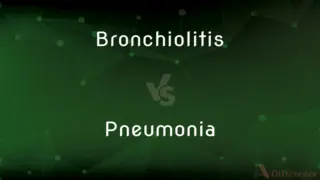Plasmolysis vs. Turgidity — What's the Difference?
By Tayyaba Rehman — Updated on September 27, 2023
Plasmolysis is the process where cells lose water causing the cytoplasm to shrink away from the cell wall, typically in hypertonic solutions. Turgidity refers to the state of being swollen or distended, usually due to the uptake of water by cells.

Difference Between Plasmolysis and Turgidity
Table of Contents
ADVERTISEMENT
Key Differences
Plasmolysis is a cellular phenomenon that occurs when a cell is placed in a hypertonic solution, leading to the loss of water from the cytoplasm, causing it to shrink and detach from the cell wall. In contrast, turgidity is the condition wherein the cell is in a hypotonic solution, water moves into the cell, and the cell swells, becoming firm and distended as it pushes against the cell wall.
Plasmolysis represents a state of cellular dehydration, a condition detrimental to the cell's survival as it can lead to the cessation of metabolic activities and possibly cell death. Turgidity, on the other hand, is crucial for plant cells, maintaining their structure and rigidity, enabling the plant to stand upright and ensuring optimum exposure to sunlight.
When a cell undergoes plasmolysis, it loses turgor pressure, a crucial component maintaining the cell's structure, leading to the cell becoming flaccid. Turgidity involves the buildup of turgor pressure against the cell wall due to water influx, preventing the cell from bursting due to osmotic pressure.
Plasmolysis can be reversed by placing the cell back into a hypotonic or isotonic solution, allowing the cell to regain water. Turgidity is regulated by the cell wall in plant cells, which withstands the internal pressure, preventing over-expansion and rupture of the cell membrane.
In conclusion, while plasmolysis and turgidity are antithetical processes related to water movement in cells, they are vital in understanding cellular responses to different environmental conditions, having implications in various biological studies and applications, especially in botany.
ADVERTISEMENT
Comparison Chart
Definition
Process of cytoplasm shrinking due to water loss in hypertonic solutions.
State of being swollen due to water uptake in hypotonic solutions.
Occurs in
Hypertonic solutions
Hypotonic solutions
Results in
Loss of turgor pressure, cell becoming flaccid.
Buildup of turgor pressure, cell becoming firm.
Implications
Detrimental to the cell, can lead to cell death.
Essential for plant rigidity and structure.
Reversibility
Can be reversed by rehydrating the cell.
Is maintained as long as the cell is in a hypotonic solution.
Compare with Definitions
Plasmolysis
A cellular process that often leads to wilting in plant cells.
The leaves of the plant exhibited plasmolysis due to the scarcity of water in the soil.
Turgidity
The state of being swollen or distended due to the absorption of fluid.
The turgidity of the plant cells kept the leaves firm and upright, optimizing light absorption.
Plasmolysis
The detachment of the cell membrane from the cell wall in hypertonic solutions.
The observation of plasmolysis under the microscope showed the retraction of the cell membrane from the cell wall.
Turgidity
A condition in cells where increased pressure is exerted against the cell wall.
The turgidity observed in the cells indicated a high water uptake, maintaining the structural integrity of the plant.
Plasmolysis
The contraction of the protoplast of a plant cell as a result of loss of water from the cell.
Plasmolysis is observed when a plant cell is placed in a highly saline solution, causing the cell to lose water and shrink.
Turgidity
A feature indicative of the presence of water, maintaining cell shape and size.
The observable turgidity in the plant cells was attributed to the sufficient water availability in the environment.
Plasmolysis
A reversible process that can be corrected by placing the cell in a hypotonic solution.
To reverse plasmolysis, the dehydrated cells were immersed in distilled water.
Turgidity
The result of water moving into a cell in a hypotonic solution.
The cells displayed turgidity when placed in a solution with lower solute concentration.
Plasmolysis
A phenomenon illustrative of osmotic pressure in plant cells.
The experiment demonstrated plasmolysis, revealing insights into osmoregulation in plant cells.
Turgidity
Essential for maintaining the structure and rigidity in plant cells.
Turgidity is crucial for the plant's survival, ensuring it can optimally photosynthesize.
Plasmolysis
Plasmolysis is the process in which cells lose water in a hypertonic solution. The reverse process, deplasmolysis or cytolysis, can occur if the cell is in a hypotonic solution resulting in a lower external osmotic pressure and a net flow of water into the cell.
Turgidity
Excessively ornate or complex in style or language; grandiloquent
Turgid prose.
Plasmolysis
Shrinkage or contraction of the protoplasm away from the wall of a living plant or bacterial cell, caused by loss of water through osmosis.
Turgidity
Swollen or distended, as from a fluid; bloated
A turgid bladder.
Turgid veins.
Plasmolysis
(biology) the shrinking of protoplasm away from the cell wall of a plant or bacterium due to water loss
Turgidity
The state or quality of being turgid.
Turgidity
The quality or state of being turgid.
Turgidity
Pompously embellished language
Common Curiosities
Is turgidity beneficial for plants?
Yes, turgidity maintains plant structure and allows plants to stand upright, optimizing light exposure.
What role does the cell wall play in turgidity?
The cell wall prevents over-expansion and rupture of the cell membrane, maintaining turgidity.
Is plasmolysis a reversible process?
Yes, plasmolysis can be reversed by placing the cell in a hypotonic or isotonic solution.
What causes plasmolysis?
Plasmolysis is caused by the cell losing water when placed in a hypertonic solution.
What is the outcome of plasmolysis in plant cells?
Plasmolysis results in the cell becoming flaccid, leading to wilting in plants.
Can plasmolysis occur in animal cells?
No, animal cells do not undergo plasmolysis; instead, they can crenate or lyse in hypertonic solutions.
Can turgidity occur in animal cells?
No, animal cells do not experience turgidity as they lack a cell wall to resist water influx.
Can plasmolysis be observed in dead cells?
No, plasmolysis can only be observed in living cells as it involves active physiological processes.
How does turgidity affect plant turgor pressure?
Turgidity increases turgor pressure, exerting pressure against the cell wall and maintaining cell shape.
How is turgidity different from rigidity in plants?
Turgidity refers to cell swelling due to water intake, while rigidity is the stiffness of plant structures due to turgidity.
How does turgidity contribute to plant cell osmoregulation?
Turgidity regulates water intake and maintains internal pressure, balancing osmotic conditions within the cell.
What are the visual signs of plasmolysis in plant cells?
Plasmolysis is marked by the shrinkage of the cytoplasm and detachment from the cell wall, often observable under a microscope.
Can plasmolysis occur in all plant cells?
Plasmolysis can occur in any plant cell exposed to hypertonic conditions, leading to water loss.
Is turgidity observable in plasmolyzed cells?
No, plasmolyzed cells lose turgidity as they lose water and become flaccid.
Is plasmolysis indicative of cell death?
Not necessarily, while plasmolysis is harmful, it can be reversible, and the cell can recover.
Share Your Discovery

Previous Comparison
Contrabassoon vs. Bassoon
Next Comparison
Bronchiolitis vs. PneumoniaAuthor Spotlight
Written by
Tayyaba RehmanTayyaba Rehman is a distinguished writer, currently serving as a primary contributor to askdifference.com. As a researcher in semantics and etymology, Tayyaba's passion for the complexity of languages and their distinctions has found a perfect home on the platform. Tayyaba delves into the intricacies of language, distinguishing between commonly confused words and phrases, thereby providing clarity for readers worldwide.
















































